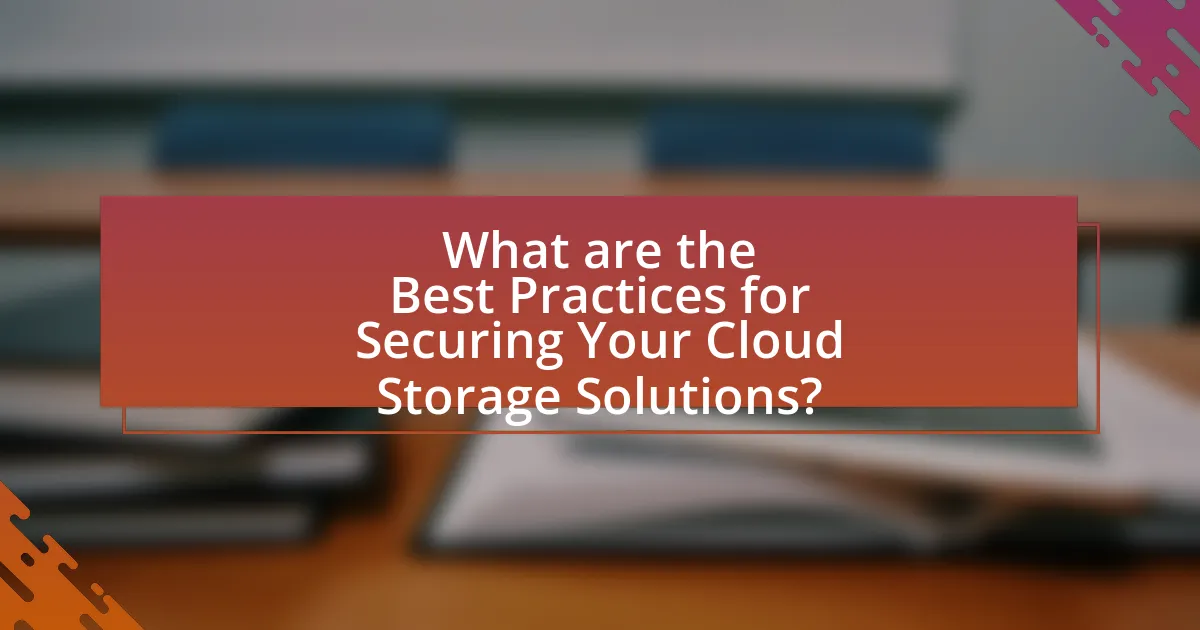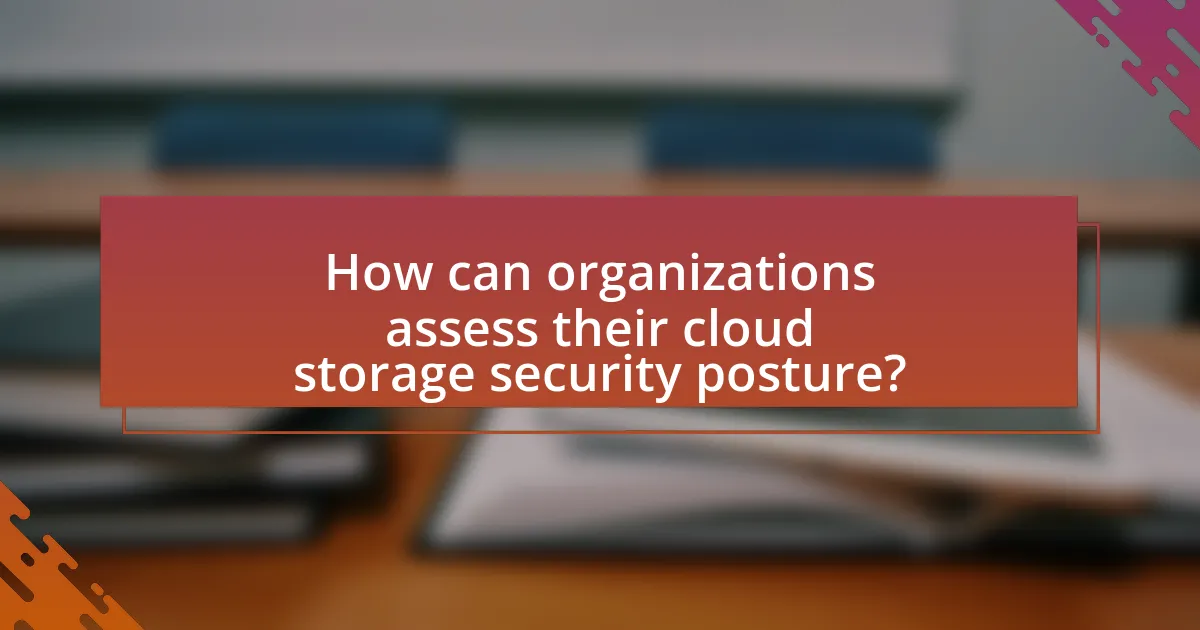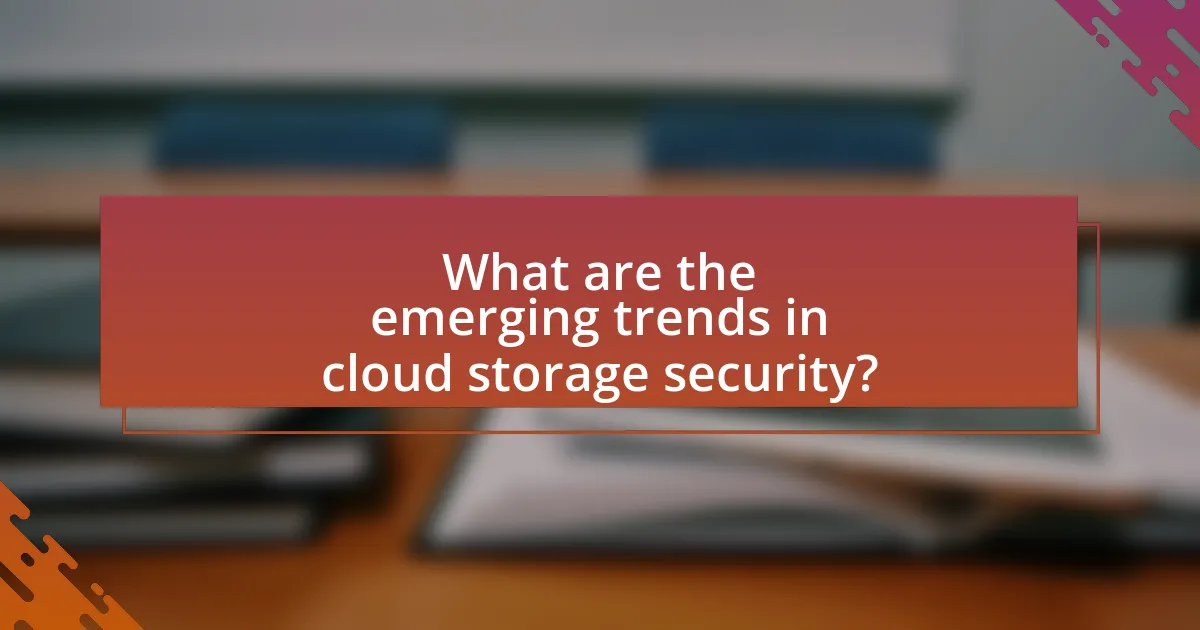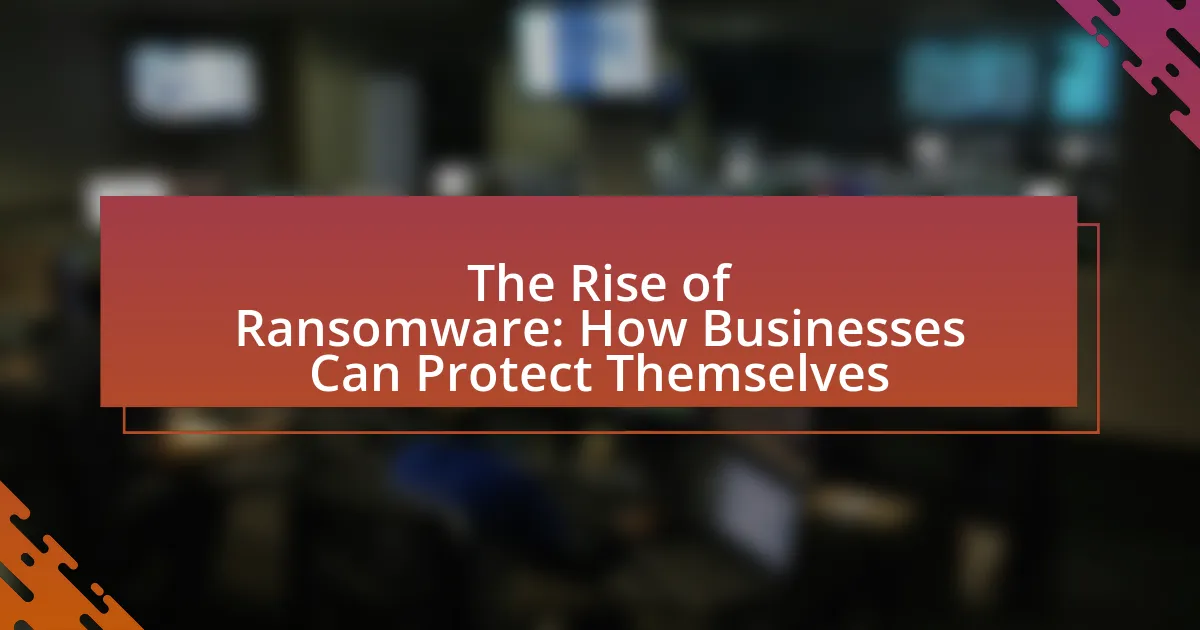The article focuses on best practices for securing cloud storage solutions, emphasizing the importance of strong encryption, multi-factor authentication, regular access control updates, and routine security audits. It highlights the critical need for businesses to protect sensitive data from unauthorized access and cyber threats, noting the significant financial implications of data breaches. Key components of cloud storage security, such as access controls and encryption, are discussed, along with strategies for assessing security posture and the role of emerging technologies like artificial intelligence. The article also addresses common mistakes to avoid and practical tips for enhancing cloud security, ensuring organizations can effectively safeguard their data in cloud environments.

What are the Best Practices for Securing Your Cloud Storage Solutions?
The best practices for securing your cloud storage solutions include implementing strong encryption, utilizing multi-factor authentication, regularly updating access controls, and conducting routine security audits. Strong encryption protects data both at rest and in transit, ensuring that unauthorized users cannot access sensitive information. Multi-factor authentication adds an additional layer of security by requiring multiple forms of verification before granting access. Regularly updating access controls helps to ensure that only authorized personnel have access to specific data, reducing the risk of insider threats. Conducting routine security audits allows organizations to identify vulnerabilities and address them proactively, thereby enhancing overall security posture. These practices are supported by industry standards and guidelines, such as those from the National Institute of Standards and Technology (NIST), which emphasize the importance of a layered security approach in cloud environments.
Why is securing cloud storage essential for businesses?
Securing cloud storage is essential for businesses to protect sensitive data from unauthorized access and cyber threats. With 94% of enterprises using cloud services, the risk of data breaches increases significantly, as evidenced by the 2021 IBM Cost of a Data Breach Report, which found that the average cost of a data breach is $4.24 million. Additionally, securing cloud storage helps ensure compliance with regulations such as GDPR and HIPAA, which mandate strict data protection measures. Therefore, implementing robust security protocols is crucial for safeguarding business information and maintaining customer trust.
What risks are associated with inadequate cloud storage security?
Inadequate cloud storage security poses significant risks, including data breaches, unauthorized access, and data loss. Data breaches can lead to sensitive information being exposed, resulting in financial loss and reputational damage for organizations. Unauthorized access occurs when individuals exploit weak security measures, potentially leading to data manipulation or theft. Additionally, data loss can happen due to insufficient backup protocols or system failures, jeopardizing critical business operations. According to a 2021 report by IBM, the average cost of a data breach is $4.24 million, highlighting the financial implications of inadequate security measures.
How can data breaches impact organizations?
Data breaches can significantly impact organizations by compromising sensitive information, leading to financial losses, reputational damage, and legal consequences. For instance, the 2017 Equifax breach exposed personal data of approximately 147 million individuals, resulting in over $4 billion in total costs, including settlements and security improvements. Additionally, organizations may face regulatory fines and lawsuits, as seen with the General Data Protection Regulation (GDPR) penalties, which can reach up to 4% of annual global revenue. The long-term effects include loss of customer trust and increased scrutiny from stakeholders, ultimately affecting business operations and growth.
What are the key components of cloud storage security?
The key components of cloud storage security include data encryption, access control, authentication, and regular security audits. Data encryption protects sensitive information by converting it into an unreadable format, ensuring that only authorized users can access it. Access control mechanisms restrict who can view or modify data, often utilizing role-based access to enforce permissions. Authentication processes, such as multi-factor authentication, verify user identities to prevent unauthorized access. Regular security audits assess the effectiveness of security measures and identify vulnerabilities, ensuring compliance with industry standards and regulations. These components collectively enhance the security posture of cloud storage solutions.
What role does encryption play in securing cloud storage?
Encryption is essential for securing cloud storage as it protects data by converting it into a format that is unreadable without the correct decryption key. This process ensures that even if unauthorized individuals gain access to the stored data, they cannot interpret it without the key. According to a report by the Cloud Security Alliance, 64% of organizations cite data encryption as a critical measure for safeguarding sensitive information in the cloud. By implementing encryption, organizations can comply with regulations such as GDPR and HIPAA, which mandate the protection of personal and sensitive data. Thus, encryption not only secures data but also helps organizations meet legal requirements.
How do access controls enhance cloud storage security?
Access controls enhance cloud storage security by restricting unauthorized access to sensitive data. By implementing role-based access controls (RBAC), organizations can ensure that only authorized users have the permissions necessary to view or modify specific files. This minimizes the risk of data breaches, as evidenced by a 2020 report from the Ponemon Institute, which found that 63% of data breaches were linked to unauthorized access. Additionally, access controls can include multi-factor authentication (MFA), which adds an extra layer of security by requiring users to provide multiple forms of verification before accessing cloud resources. This combination of measures significantly strengthens the overall security posture of cloud storage solutions.
What strategies can be implemented to secure cloud storage?
To secure cloud storage, organizations should implement encryption, access controls, and regular audits. Encryption protects data both at rest and in transit, ensuring that unauthorized users cannot access sensitive information. Access controls, such as multi-factor authentication and role-based permissions, limit data access to authorized personnel only, reducing the risk of breaches. Regular audits help identify vulnerabilities and ensure compliance with security policies. According to a 2021 report by the Cloud Security Alliance, 64% of organizations experienced a cloud security incident, highlighting the importance of these strategies in mitigating risks.
How can regular audits improve cloud storage security?
Regular audits can significantly enhance cloud storage security by identifying vulnerabilities and ensuring compliance with security policies. These audits systematically evaluate access controls, data encryption, and user activity, allowing organizations to detect unauthorized access or data breaches. For instance, a study by the Cloud Security Alliance found that 70% of data breaches are due to misconfigured cloud settings, which regular audits can help uncover. By implementing regular audits, organizations can proactively address security gaps, thereby reducing the risk of data loss and enhancing overall cloud security posture.
What are the benefits of multi-factor authentication?
Multi-factor authentication (MFA) significantly enhances security by requiring users to provide multiple forms of verification before accessing accounts. This method reduces the risk of unauthorized access, as it combines something the user knows (like a password) with something the user has (like a mobile device) or something the user is (like a fingerprint). According to a study by the Cybersecurity & Infrastructure Security Agency, MFA can block over 99% of automated cyberattacks, demonstrating its effectiveness in protecting sensitive data stored in cloud solutions.

How can organizations assess their cloud storage security posture?
Organizations can assess their cloud storage security posture by conducting regular security audits and vulnerability assessments. These evaluations involve reviewing access controls, encryption methods, and compliance with industry standards such as ISO 27001 or NIST guidelines. Additionally, organizations should implement continuous monitoring tools to detect anomalies and potential threats in real-time. According to a 2021 report by the Cloud Security Alliance, 70% of organizations that regularly assess their cloud security posture report improved risk management and compliance.
What tools are available for evaluating cloud storage security?
Tools available for evaluating cloud storage security include cloud security assessment tools, encryption assessment tools, and compliance management tools. Cloud security assessment tools, such as CloudCheckr and Prisma Cloud, provide visibility into security configurations and vulnerabilities in cloud environments. Encryption assessment tools, like CipherTrust and AWS Key Management Service, evaluate the effectiveness of data encryption practices. Compliance management tools, such as Qualys and Tenable.io, help organizations ensure adherence to regulatory standards and best practices. These tools collectively enable organizations to assess and enhance the security posture of their cloud storage solutions effectively.
How do vulnerability assessments contribute to security improvements?
Vulnerability assessments contribute to security improvements by identifying weaknesses in systems and applications before they can be exploited by attackers. These assessments systematically evaluate the security posture of cloud storage solutions, allowing organizations to prioritize remediation efforts based on the severity of identified vulnerabilities. For instance, a study by the Ponemon Institute found that organizations that conduct regular vulnerability assessments reduce their risk of data breaches by up to 30%. By addressing vulnerabilities proactively, organizations enhance their overall security framework, ensuring that cloud storage solutions are better protected against potential threats.
What metrics should organizations track for cloud security effectiveness?
Organizations should track metrics such as the number of security incidents, time to detect and respond to threats, compliance status, and user access patterns to evaluate cloud security effectiveness. Monitoring the number of security incidents helps organizations understand the frequency and severity of breaches, while tracking the time to detect and respond indicates the efficiency of their security protocols. Compliance status ensures adherence to regulations and standards, and analyzing user access patterns can reveal potential insider threats or unauthorized access attempts. These metrics collectively provide a comprehensive view of an organization’s cloud security posture.
What common mistakes should be avoided in cloud storage security?
Common mistakes to avoid in cloud storage security include weak password practices, inadequate access controls, and neglecting data encryption. Weak passwords can be easily compromised, leading to unauthorized access; therefore, implementing strong, unique passwords is essential. Inadequate access controls can result in excessive permissions granted to users, increasing the risk of data breaches; organizations should enforce the principle of least privilege. Neglecting data encryption, both in transit and at rest, exposes sensitive information to potential interception and unauthorized access; using robust encryption methods is crucial for safeguarding data integrity and confidentiality.
How can poor password management compromise cloud storage security?
Poor password management can significantly compromise cloud storage security by allowing unauthorized access to sensitive data. When users employ weak passwords, reuse passwords across multiple accounts, or fail to update them regularly, they increase the risk of credential theft. For instance, a study by Verizon in their 2021 Data Breach Investigations Report indicated that 61% of data breaches involved stolen credentials, highlighting the critical role of password security. Additionally, if passwords are stored insecurely or shared without proper safeguards, it further exposes cloud storage to potential breaches. Thus, inadequate password practices directly correlate with heightened vulnerability in cloud storage environments.
What are the dangers of neglecting software updates?
Neglecting software updates poses significant dangers, including increased vulnerability to security breaches. When software is not updated, it lacks the latest security patches that protect against known exploits; for instance, a study by the Ponemon Institute found that 60% of data breaches are linked to unpatched vulnerabilities. Additionally, outdated software can lead to compatibility issues with newer applications, resulting in operational inefficiencies. Furthermore, failure to update can expose sensitive data to malware attacks, as cybercriminals often target outdated systems. Therefore, regular software updates are essential for maintaining security and functionality in cloud storage solutions.

What are the emerging trends in cloud storage security?
Emerging trends in cloud storage security include the adoption of zero-trust security models, enhanced encryption techniques, and the integration of artificial intelligence for threat detection. The zero-trust model operates on the principle of “never trust, always verify,” ensuring that every access request is authenticated and authorized, which significantly reduces the risk of data breaches. Enhanced encryption techniques, such as homomorphic encryption, allow data to be processed in its encrypted form, providing an additional layer of security. Furthermore, artificial intelligence is increasingly utilized to analyze patterns and detect anomalies in real-time, enabling proactive responses to potential threats. These trends are supported by industry reports indicating that organizations implementing these strategies have seen a marked improvement in their security posture.
How is artificial intelligence shaping cloud storage security?
Artificial intelligence is significantly enhancing cloud storage security by enabling advanced threat detection and response mechanisms. AI algorithms analyze vast amounts of data in real-time to identify unusual patterns and potential security breaches, which traditional methods may overlook. For instance, a study by McAfee found that organizations using AI for security saw a 50% reduction in the time taken to detect and respond to threats. Additionally, AI-driven tools can automate security protocols, such as encryption and access controls, ensuring that sensitive data remains protected against unauthorized access. This proactive approach not only strengthens security measures but also reduces the overall risk of data breaches in cloud storage environments.
What are the implications of AI-driven security solutions?
AI-driven security solutions enhance threat detection and response capabilities, significantly improving overall cybersecurity. These solutions utilize machine learning algorithms to analyze vast amounts of data in real-time, identifying patterns indicative of potential threats. For instance, a study by McKinsey & Company found that organizations employing AI in their security frameworks can reduce incident response times by up to 90%. Additionally, AI-driven systems can adapt to evolving threats, providing a proactive defense mechanism that traditional security measures often lack. This adaptability is crucial as cyber threats become increasingly sophisticated, underscoring the importance of integrating AI into cloud storage security practices.
How can machine learning enhance threat detection in cloud storage?
Machine learning enhances threat detection in cloud storage by analyzing vast amounts of data to identify patterns indicative of security threats. This technology employs algorithms that can learn from historical data, enabling it to detect anomalies such as unusual access patterns or unauthorized data modifications. For instance, a study by IBM found that machine learning models can reduce false positive rates in threat detection by up to 50%, significantly improving the accuracy of identifying genuine threats. By continuously learning from new data, machine learning systems adapt to evolving threats, ensuring that cloud storage solutions remain secure against sophisticated attacks.
What future challenges might organizations face in cloud storage security?
Organizations will face several future challenges in cloud storage security, including increasing sophistication of cyberattacks, regulatory compliance complexities, and data privacy concerns. As cybercriminals develop more advanced techniques, organizations must continuously enhance their security measures to protect sensitive data. For instance, the number of ransomware attacks has surged, with a 150% increase reported in 2020 alone, highlighting the urgent need for robust security protocols. Additionally, as regulations like GDPR and CCPA evolve, organizations will need to navigate a complex landscape of compliance requirements, which can strain resources and complicate data management strategies. Lastly, the growing emphasis on data privacy will require organizations to implement stringent access controls and encryption methods to safeguard personal information, further complicating their cloud storage security efforts.
How will evolving regulations impact cloud storage security practices?
Evolving regulations will significantly enhance cloud storage security practices by mandating stricter compliance measures. As governments and regulatory bodies implement new data protection laws, such as the General Data Protection Regulation (GDPR) in Europe and the California Consumer Privacy Act (CCPA) in the United States, organizations will be required to adopt more robust security protocols to protect sensitive information. These regulations often necessitate encryption, access controls, and regular security audits, compelling cloud service providers to improve their security frameworks. For instance, GDPR imposes heavy fines for data breaches, incentivizing companies to prioritize security to avoid financial penalties. Consequently, the landscape of cloud storage security will increasingly focus on compliance-driven practices, ensuring that data is not only stored securely but also managed in accordance with legal requirements.
What role will user education play in future security strategies?
User education will play a critical role in future security strategies by enhancing awareness and understanding of security risks among users. As cyber threats evolve, educated users can recognize phishing attempts, manage passwords effectively, and utilize security features in cloud storage solutions. Research indicates that organizations with comprehensive user training programs experience a 70% reduction in security incidents, demonstrating the effectiveness of education in mitigating risks. Therefore, integrating user education into security strategies is essential for fostering a proactive security culture and reducing vulnerabilities in cloud storage environments.
What practical tips can enhance cloud storage security today?
To enhance cloud storage security today, implement strong encryption for data both at rest and in transit. Encryption protects sensitive information from unauthorized access, ensuring that even if data is intercepted, it remains unreadable without the decryption key. According to a 2021 report by the Cloud Security Alliance, 64% of organizations that adopted encryption reported a significant reduction in data breaches. Additionally, enable multi-factor authentication (MFA) to add an extra layer of security, making it more difficult for unauthorized users to gain access. Regularly update and patch cloud storage applications to protect against vulnerabilities, as outdated software can be an easy target for cyberattacks. Lastly, conduct regular security audits and assessments to identify and mitigate potential risks, ensuring that security measures remain effective and up-to-date.
How can organizations create a robust cloud security policy?
Organizations can create a robust cloud security policy by implementing a comprehensive framework that includes risk assessment, access controls, data encryption, and continuous monitoring. Conducting a risk assessment helps identify vulnerabilities and threats specific to the organization’s cloud environment, enabling tailored security measures. Establishing strict access controls ensures that only authorized personnel can access sensitive data, reducing the risk of insider threats. Utilizing data encryption protects information both at rest and in transit, making it unreadable to unauthorized users. Continuous monitoring of cloud resources allows organizations to detect and respond to security incidents in real-time, thereby enhancing overall security posture. According to the Cloud Security Alliance, organizations that adopt these practices significantly reduce their risk of data breaches and compliance violations.
What best practices should be followed for data backup and recovery?
The best practices for data backup and recovery include implementing a 3-2-1 backup strategy, which involves keeping three copies of data, storing two copies on different media, and maintaining one copy offsite. This approach minimizes the risk of data loss due to hardware failure, natural disasters, or cyberattacks. Regularly testing backup restoration processes is crucial to ensure data can be recovered effectively when needed. Additionally, using encryption for backups protects sensitive information from unauthorized access. According to a study by the Ponemon Institute, 60% of companies that lose their data will shut down within six months, highlighting the importance of robust backup and recovery practices.




